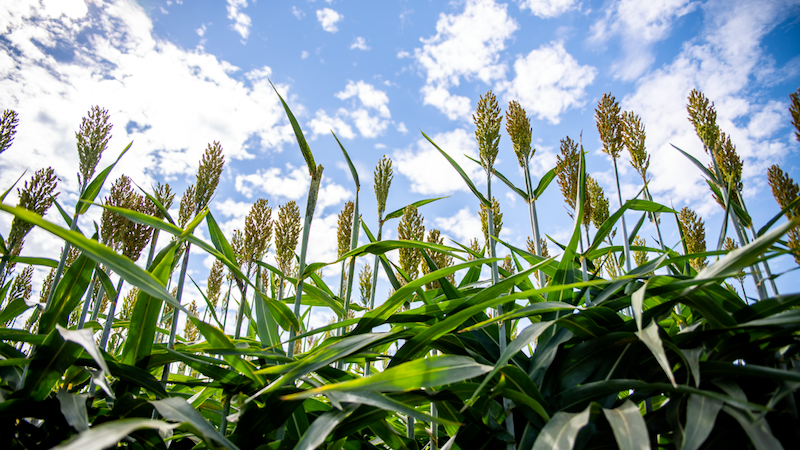Apr 7 2020
Biofuels are viewed as an integral part of the wider plan to substitute jet fuels as well as petroleum-based gasoline and diesel that are being used today. But so far, biofuels have not reached the cost parity with respect to traditional petroleum fuels.
 Sorghum, shown here at the Agronomy Field Headquarters in Davis, California, is a common bioenergy crop and was used in this study. Image Credit: Marilyn Sargent/Lawrence Berkeley National Laboratory.
Sorghum, shown here at the Agronomy Field Headquarters in Davis, California, is a common bioenergy crop and was used in this study. Image Credit: Marilyn Sargent/Lawrence Berkeley National Laboratory.
One promising method is to make biofuels more competitive by making plants to perform some of the work on their own.
Researchers can breed plants to yield useful bioproducts, or chemical compounds, as they develop. The resultant bioproducts can be subsequently extracted from the plant and the residual plant material can be changed into fuel. If bioproducts are generated in the plant itself, they can help in decreasing the cost of the biofuel obtained.
However, a significant part of this method has continued to be vague—what is the exact amount of a specific bioproduct that plants need to make to render the process economically viable?
Scientists at the Department of Energy’s Lawrence Berkeley National Laboratory (Berkeley Lab) and also at the Department of Energy’s Joint BioEnergy Institute (JBEI), which is handled by Berkeley Lab, have now given the original definition of this amount.
The researchers’ study was jointly headed by Corinne Scown and Patrick Shih, and was recently published in the Proceedings of the National Academy of Sciences journal.
The team initially collected data on a group of extensively researched bioproducts that are already successfully produced by plants—spanning from fragrances and flavors through to biodegradable plastics. Creating a useful bioproduct would not only compensate for the cost of producing the biofuels but would also make the entire process more cost-effective.
“It’s a really elegant solution, to be able to engineer a plant to directly accumulate a valuable bioproduct,” stated Scown, a researcher in JBEI and Berkeley Lab’s Energy Technologies Area.
The researchers ultimately developed and replicated the factors that would be required to obtain these bioproducts from plant material in the setting of an ethanol biorefinery. In this context, useful bioproducts would be obtained from the plant material, while the residual plant material would be transformed into ethanol.
This allowed the researchers to answer two major questions—what is the amount of bioproduct that the plant has to produce to make the extraction process meaningful. and what is the amount that needs to be made to reach the target selling cost of $2.50 for each gallon of ethanol?
To the researchers’ surprise, the results revealed that the amount required by plants to make is, in fact, quite viable. For instance, the researchers calculated that when a compound such as limonene is accumulated at 0.6% of the biomass dry weight, it would provide net economic benefits to bio-refineries.
This means, if bio-refineries are able to harvest 10 dry metric tons of sorghum biomass from an acre of land, they would need to recover just about 130 pounds of limonene from that biomass. Incidentally, the limonene is used in fragrance and flavor products.
The researchers in our Feedstocks Division were surprised by how modest the target levels were. The levels we need to accumulate in plants to offset the cost of bioproduct recovery and drive down the price of biofuels are well within reach.
Corinne Scown, Researcher, Joint BioEnergy Institute, Department of Energy and Energy Technologies Area, Berkeley Lab
The team’s results demonstrate that this method of decreasing the cost of biofuels is quite viable—but researchers are cautioned to exercise some restraint in this regard because the market for every high-value product is restricted in size.
The researchers’ analysis indicates that five large-scale biorefineries alone would be able to supply the whole estimated 2025 market demand for the limonene compound.
According to Scown, crops had to be designed to yield an array of products to ensure that the sector is diversified and that the market is not flooded with any single product.
With techno-economic models, this research provides new insights into the role of bioproducts in improving the economics of biorefineries.
Minliang Yang, Study Lead Author and Postdoctoral Researcher, Joint BioEnergy Institute, Department of Energy
The largest impact of the paper is that it provides the first quantitative foundation to actually apply this cost-saving plan, offering a preliminary point for researchers who are looking for ways to breed or engineer plants that produce bioproducts themselves and consequently offset the cost of producing biofuels, informed Scown.
I think this research is just the first step to demonstrating the future potential of engineered bioenergy feedstock crops. I would imagine that our findings will help motivate future efforts to make biofuels economically viable.
Patrick Shih, Director of Plant Biosystems Design, Joint BioEnergy Institute, Department of Energy
The study was financially supported by the DOE Office of Science.